Assessment of Bottom-Up Satellite Precipitation Products on River Streamflow Estimations in the Peruvian Pacific Drainage
Abstract
:1. Introduction
2. Materials
2.1. Study Area
2.2. Datasets
2.2.1. Surface Observations
2.2.2. Gridded Precipitation Products
3. Methods
3.1. Hydrological Modeling
3.2. Performance Evaluation of the 3 Precipitation Products
3.3. Evaluation of the Series Using Skill Score and Hydrological Signatures
3.3.1. Skill Score
3.3.2. Hydrological Signatures
4. Results
4.1. Performance of Satellite Products in the Evaluation Stages
4.2. Evaluation of the Performance of Precipitation Products in the Pd
4.3. Spatial Performance Evaluation by Areas of the Precipitation Products
4.4. Improved Performance
4.5. Reliability of Remote Sensing Products on Hydrologic Signatures
5. Discussions
5.1. Intrinsic Quality of Satellite Precipitation Products
5.2. Performance of Hydrological Modeling on the Pd
6. Conclusions
Author Contributions
Funding
Data Availability Statement
Acknowledgments
Conflicts of Interest
References
- Maggioni, V.; Massari, C. On the Performance of Satellite Precipitation Products in Riverine Flood Modeling: A Review. J. Hydrol. 2018, 558, 214–224. [Google Scholar] [CrossRef]
- Eini, M.R.; Rahmati, A.; Salmani, H.; Brocca, L.; Piniewski, M. Detecting Characteristics of Extreme Precipitation Events Using Regional and Satellite-Based Precipitation Gridded Datasets over a Region in Central Europe. Sci. Total Environ. 2022, 852, 158497. [Google Scholar] [CrossRef] [PubMed]
- Muhammad, E.; Muhammad, W.; Ahmad, I.; Muhammad Khan, N.; Chen, S. Satellite Precipitation Product: Applicability and Accuracy Evaluation in Diverse Region. Sci. China Technol. Sci. 2020, 63, 819–828. [Google Scholar] [CrossRef]
- IPCC. Summary for Policymakers. In Climate Change 2023: Synthesis Report. Contribution of Working Groups I, II and III to the Sixth Assessment Report of the Intergovernmental Panel on Climate Change; Core Writing Team, Lee, H., Romero, J., Eds.; IPCC: Geneva, Switzerland, 2023; pp. 1–34. [Google Scholar] [CrossRef]
- Donnelly, J.; Abolfathi, S.; Pearson, J.; Chatrabgoun, O.; Daneshkhah, A. Gaussian Process Emulation of Spatio-Temporal Outputs of a 2D Inland Flood Model. Water Res. 2022, 225, 119100. [Google Scholar] [CrossRef] [PubMed]
- Mahdian, M.; Hosseinzadeh, M.; Siadatmousavi, S.M.; Chalipa, Z.; Delavar, M.; Guo, M.; Abolfathi, S.; Noori, R. Modelling Impacts of Climate Change and Anthropogenic Activities on Inflows and Sediment Loads of Wetlands: Case Study of the Anzali Wetland. Sci. Rep. 2023, 13, 5399. [Google Scholar] [CrossRef] [PubMed]
- Kreibich, H.; Van Loon, A.F.; Schröter, K.; Ward, P.J.; Mazzoleni, M.; Sairam, N.; Abeshu, G.W.; Agafonova, S.; AghaKouchak, A.; Aksoy, H.; et al. The Challenge of Unprecedented Floods and Droughts in Risk Management. Nature 2022, 608, 80–86. [Google Scholar] [CrossRef] [PubMed]
- Brocca, L.; Massari, C.; Pellarin, T.; Filippucci, P.; Ciabatta, L.; Camici, S.; Kerr, Y.H.; Fernández-Prieto, D. River Flow Prediction in Data Scarce Regions: Soil Moisture Integrated Satellite Rainfall Products Outperform Rain Gauge Observations in West Africa. Sci. Rep. 2020, 10, 12517. [Google Scholar] [CrossRef]
- Hong, Y.; Hsu, K.L.; Moradkhani, H.; Sorooshian, S. Uncertainty Quantification of Satellite Precipitation Estimation and Monte Carlo Assessment of the Error Propagation into Hydrologic Response. Water Resour. Res. 2006, 42, 1–15. [Google Scholar] [CrossRef]
- Brocca, L.; Moramarco, T.; Melone, F.; Wagner, W. A New Method for Rainfall Estimation through Soil Moisture Observations. Geophys. Res. Lett. 2013, 40, 853–858. [Google Scholar] [CrossRef]
- Brocca, L.; Filippucci, P.; Hahn, S.; Ciabatta, L.; Massari, C.; Camici, S.; Schüller, L.; Bojkov, B.; Wagner, W. SM2RAIN-ASCAT (2007–2018): Global Daily Satellite Rainfall Data from ASCAT Soil Moisture Observations. Earth Syst. Sci. Data 2019, 11, 1583–1601. [Google Scholar] [CrossRef]
- Abera, W.; Formetta, G.; Brocca, L.; Rigon, R. Modeling the Water Budget of the Upper Blue Nile Basin Using the JGrass-NewAge Model System and Satellite Data. Hydrol. Earth Syst. Sci. 2017, 21, 3145–3165. [Google Scholar] [CrossRef]
- Massari, C.; Brocca, L.; Pellarin, T.; Abramowitz, G.; Filippucci, P.; Ciabatta, L.; Maggioni, V.; Kerr, Y.; Fernandez Prieto, D. A Daily 25 km Short-Latency Rainfall Product for Data-Scarce Regions Based on the Integration of the Global Precipitation Measurement Mission Rainfall and Multiple-Satellite Soil Moisture Products. Hydrol. Earth Syst. Sci. 2020, 24, 2687–2710. [Google Scholar] [CrossRef]
- Satgé, F.; Hussain, Y.; Molina-Carpio, J.; Pillco, R.; Laugner, C.; Akhter, G.; Bonnet, M.P. Reliability of SM2RAIN Precipitation Datasets in Comparison to Gauge Observations and Hydrological Modelling over Arid Regions. Int. J. Climatol. 2021, 41, E517–E536. [Google Scholar] [CrossRef]
- Guo, B.; Xu, T.; Yang, Q.; Zhang, J.; Dai, Z.; Deng, Y.; Zou, J.; Ling, F.; Nakamura, K.; Guo, B.; et al. Multiple Spatial and Temporal Scales Evaluation of Eight Satellite Precipitation Products in a Mountainous Catchment of South China. Remote Sens. 2023, 15, 1373. [Google Scholar] [CrossRef]
- Paredes-Trejo, F.; Barbosa, H.; dos Santos, C.A.C. Evaluation of the Performance of SM2RAIN-Derived Rainfall Products over Brazil. Remote Sens. 2019, 11, 1113. [Google Scholar] [CrossRef]
- Ciabatta, L.; Massari, C.; Brocca, L.; Gruber, A.; Reimer, C.; Hahn, S.; Paulik, C.; Dorigo, W.; Kidd, R.; Wagner, W. SM2RAIN-CCI: A New Global Long-Term Rainfall Data Set Derived from ESA CCI Soil Moisture. Earth Syst. Sci. Data 2018, 10, 267–280. [Google Scholar] [CrossRef]
- Almagro, A.; Oliveira, P.T.S.; Meira Neto, A.A.; Roy, T.; Troch, P. CABra: A Novel Large-Sample Dataset for Brazilian Catchments. Hydrol. Earth Syst. Sci. 2021, 25, 3105–3135. [Google Scholar] [CrossRef]
- Jafarzadegan, K.; Moradkhani, H.; Pappenberger, F.; Moftakhari, H.; Bates, P.; Abbaszadeh, P.; Marsooli, R.; Ferreira, C.; Cloke, H.L.; Ogden, F.; et al. Recent Advances and New Frontiers in Riverine and Coastal Flood Modeling. Rev. Geophys. 2023, 61, e2022RG000788. [Google Scholar] [CrossRef]
- Burgan, H.I. Comparison of Different ANN (FFBP, GRNN, RBF) Algorithms and Multiple Linear Regression for Daily Streamflow Prediction in Kocasu River, Turkey. Fresenius Environ. Bull. 2022, 31, 4699–4708. [Google Scholar]
- Hachmi, A. New Investigation and Challenge for Spatiotemporal Drought Monitoring Using Bottom-Up Precipitation Dataset (SM2RAIN-ASCAT) and NDVI in Moroccan Arid and Semi-Arid Rangelands. Ekológia 2022, 41, 90–100. [Google Scholar] [CrossRef]
- Satgé, F.; Pillot, B.; Roig, H.; Bonnet, M.P. Are Gridded Precipitation Datasets a Good Option for Streamflow Simulation across the Juruá River Basin, Amazon? J. Hydrol. 2021, 602, 126773. [Google Scholar] [CrossRef]
- Ur Rahman, K.; Shang, S.; Shahid, M.; Li, J. Developing an Ensemble Precipitation Algorithm from Satellite Products and Its Topographical and Seasonal Evaluations Over Pakistan. Remote Sens. 2018, 10, 1835. [Google Scholar] [CrossRef]
- Zhang, L.; Li, X.; Cao, Y.; Nan, Z.; Wang, W.; Ge, Y.; Wang, P.; Yu, W. Evaluation and Integration of the Top-down and Bottom-up Satellite Precipitation Products over Mainland China. J. Hydrol. 2020, 581, 124456. [Google Scholar] [CrossRef]
- Rau, P.; Bourrel, L.; Labat, D.; Ruelland, D.; Frappart, F.; Lavado, W.; Dewitte, B.; Felipe, O. Assessing Multidecadal Runoff (1970–2010) Using Regional Hydrological Modelling under Data and Water Scarcity Conditions in Peruvian Pacific Catchments. Hydrol. Process. 2019, 33, 20–35. [Google Scholar] [CrossRef]
- Curi Tapahuasco, S. Caracterización de de Las Sequías Hidrológicas En La Vertiente Peruana Del Océano Pacífico; Universidad Nacional Agraria La Molina (UNALM): Lima, Peru, 2017. [Google Scholar]
- Rau, P.; Bourrel, L.; Labat, D.; Frappart, F.; Ruelland, D.; Lavado, W.; Dewitte, B.; Felipe, O. Hydroclimatic Change Disparity of Peruvian Pacific Drainage Catchments. Theor. Appl. Climatol. 2018, 134, 139–153. [Google Scholar] [CrossRef]
- ANA. Demarcación y Delimitación de Las Autoridades Administrativas Del Agua; Autoridad Nacional del Agua (ANA): Lima, Peru, 2009; Volume 1, p. 48.
- SENAMHI. Climas Del Perú: Mapa de Clasificación Climática Nacional, Resumen Ejecutivo; Repositorio Institucional SENAMHI: Lima, Peru, 2020. [Google Scholar]
- Aybar Camacho, C.L.; Lavado-Casimiro, W.; Huerta, A.; Fernández Palomino, C.; Vega-Jácome, F.; Sabino Rojas, E.; Felipe-Obando, O. Uso Del Producto Grillado PISCO de Precipitación En Estudios, Investigaciones y Sistemas Operacionales de Monitoreo y Pronóstico Hidrometeorológico; Nota Técnica No. 001 SENAMHI-DHI-2017; Repositorio Institucional SENAMHI: Lima, Peru, 2017. [Google Scholar]
- Hersbach, H.; Bell, B.; Berrisford, P.; Hirahara, S.; Horányi, A.; Muñoz-Sabater, J.; Nicolas, J.; Peubey, C.; Radu, R.; Schepers, D.; et al. The ERA5 Global Reanalysis. Q. J. R. Meteorol. Soc. 2020, 146, 1999–2049. [Google Scholar] [CrossRef]
- Huerta, A.; Bonnesoeur, V.; Cuadros-Adriazola, J.; Gutierrez, L.; Ochoa-Tocachi, B.F.; Román-Dañobeytia, F.; Lavado-Casimiro, W. PISCOeo_pm, a Reference Evapotranspiration Gridded Database Based on FAO Penman-Monteith in Peru. Sci. Data 2022, 9, 328. [Google Scholar] [CrossRef]
- Perrin, C.; Michel, C.; Andréassian, V. Improvement of a Parsimonious Model for Streamflow Simulation. J. Hydrol. 2003, 279, 275–289. [Google Scholar] [CrossRef]
- Asurza Véliz, F.A.; Ramos Taipe, C.L.; Lavado Casimiro, W.S. Evaluación de Los Productos Tropical Rainfall Measuring Mission (TRMM) y Global Precipitation Measurement (GPM) En El Modelamiento Hidrológico de La Cuenca Del Río Huancané, Perú. Sci. Agropecu. 2018, 9, 53–62. [Google Scholar] [CrossRef]
- Ticona-Flores, M.A.; Valarezo-Loaiza, J.D.; Carmona-Arteaga, A.; Vereaua-Miranda, E.A. Daily Flow Generation Using the GR4j Model and ERA5 Gridded Climatic Information in the Jequetepeque Basin up to the Yonan Station. In Proceedings of the Leadership in Education and Innovation in Engineering in the Framework of Global Transformations: Integration and Alliances for Integral Development, Buenos Aires, Argentina, 19–21 July 2023; ISBN 978-628-95207-4-3. [Google Scholar] [CrossRef]
- Zambrano-Bigiarini, M.; Rojas, R. A Model-Independent Particle Swarm Optimisation Software for Model Calibration. Environ. Model. Softw. 2013, 43, 5–25. [Google Scholar] [CrossRef]
- Kundu, D.; Vervoort, R.W.; van Ogtrop, F.F. The Value of Remotely Sensed Surface Soil Moisture for Model Calibration Using SWAT. Hydrol. Process. 2017, 31, 2764–2780. [Google Scholar] [CrossRef]
- Thiemig, V.; Rojas, R.; Zambrano-Bigiarini, M.; De Roo, A. Hydrological Evaluation of Satellite-Based Rainfall Estimates over the Volta and Baro-Akobo Basin. J. Hydrol. 2013, 499, 324–338. [Google Scholar] [CrossRef]
- Alfieri, L.; Burek, P.; Feyen, L.; Forzieri, G. Global Warming Increases the Frequency of River Floods in Europe. Hydrol. Earth Syst. Sci. 2015, 19, 2247–2260. [Google Scholar] [CrossRef]
- Bisselink, B.; Zambrano-Bigiarini, M.; Burek, P.; de Roo, A. Assessing the Role of Uncertain Precipitation Estimates on the Robustness of Hydrological Model Parameters under Highly Variable Climate Conditions. J. Hydrol. Reg. Stud. 2016, 8, 112–129. [Google Scholar] [CrossRef]
- Brauer, C.C.; Teuling, A.J.; Torfs, P.J.J.F.; Uijlenhoet, R. The Wageningen Lowland Runoff Simulator (WALRUS): A Lumped Rainfall-Runoff Model for Catchments with Shallow Groundwater. Geosci. Model Dev. 2014, 7, 2313–2332. [Google Scholar] [CrossRef]
- Qquenta, J.G.; Astorayme, M.A.; Gutiérrez, R.R.; Lavado, W.S. Assessment, Evaluation, and Code Development of the Particle Swarm Optimisation (PSO) Method for an Automatic Calibration of the TOPMODEL. In Proceedings of the World Environmental and Water Resources Congress, Atlanta, GA, USA, 5–8 June 2022; pp. 1232–1241. [Google Scholar] [CrossRef]
- Hwang, S.H.; Ham, D.H.; Kim, J.H. Une Nouvelle Mesure de l’efficacité Des Modéles Hydrologiques de Prévision Pilotés Par Les Données. Hydrol. Sci. J. 2012, 57, 1257–1274. [Google Scholar] [CrossRef]
- García, R.S. MINERVE—Technical Manual. Technical Report, RS MINERVE Group. Available online: https://scholar.google.com/scholar?hl=en&as_sdt=0%2C5&q=Garc’ıa%2C+J.%2C+Paredes%2C+J.%2C+Foehn%2C+A.%2C+and+Roquier%2C+B.+%282016%29.+RS+MINERVE+–+Technical+manual.+Technical+report%2C+RS+MINERVE+Group.&btnG= (accessed on 18 June 2023).
- Moriasi, D.N.; Gitau, M.W.; Pai, N.; Daggupati, P.; Gitau, M.W.; Member, A.; Moriasi, D.N. Hydrologic and Water Quality Models: Performance Measures and Evaluation Criteria. Trans. ASABE 2015, 58, 1763–1785. [Google Scholar] [CrossRef]
- Gnann, S.J.; Coxon, G.; Woods, R.A.; Howden, N.J.K.; McMillan, H.K. TOSSH: A Toolbox for Streamflow Signatures in Hydrology. Environ. Model. Softw. 2021, 138, 104983. [Google Scholar] [CrossRef]
- Jiang, L.; Bauer-Gottwein, P. How Do GPM IMERG Precipitation Estimates Perform as Hydrological Model Forcing? Evaluation for 300 Catchments across Mainland China. J. Hydrol. 2019, 572, 486–500. [Google Scholar] [CrossRef]
- Fan, Y.; Ma, Z.; Ma, Y.; Ma, W.; Xie, Z.; Ding, L.; Han, Y.; Hu, W.; Su, R. Respective Advantages of “Top-Down” Based GPM IMERG and “Bottom-Up” Based SM2RAIN-ASCAT Precipitation Products Over the Tibetan Plateau. J. Geophys. Res. Atmos. 2021, 126, e2020JD033946. [Google Scholar] [CrossRef]
- Hamza, A.; Anjum, M.N.; Cheema, M.J.M.; Chen, X.; Afzal, A.; Azam, M.; Shafi, M.K.; Gulakhmadov, A. Assessment of IMERG-V06, TRMM-3B42V7, SM2RAIN-ASCAT, and PERSIANN-CDR Precipitation Products over the Hindu Kush Mountains of Pakistan, South Asia. Remote Sens. 2020, 12, 3871. [Google Scholar] [CrossRef]
- Prakash, S. Performance Assessment of CHIRPS, MSWEP, SM2RAIN-CCI, and TMPA Precipitation Products across India. J. Hydrol. 2019, 571, 50–59. [Google Scholar] [CrossRef]
- Amjad, M.; Yilmaz, M.T.; Yucel, I.; Yilmaz, K.K. Performance Evaluation of Satellite- and Model-Based Precipitation Products over Varying Climate and Complex Topography. J. Hydrol. 2020, 584, 124707. [Google Scholar] [CrossRef]
- Gebremicael, T.G.; Deitch, M.J.; Gancel, H.N.; Croteau, A.C.; Haile, G.G.; Beyene, A.N.; Kumar, L. Satellite-Based Rainfall Estimates Evaluation Using a Parsimonious Hydrological Model in the Complex Climate and Topography of the Nile River Catchments. Atmos. Res. 2022, 266, 105939. [Google Scholar] [CrossRef]
- Li, X.; Zhang, Q.; Xu, C.Y. Assessing the Performance of Satellite-Based Precipitation Products and Its Dependence on Topography over Poyang Lake Basin. Theor. Appl. Climatol. 2014, 115, 713–729. [Google Scholar] [CrossRef]
- Iqbal, M.F.; Athar, H. Validation of Satellite Based Precipitation over Diverse Topography of Pakistan. Atmos. Res. 2018, 201, 247–260. [Google Scholar] [CrossRef]
- Rodríguez-Fernández, N.J.; Muñoz Sabater, J.; Richaume, P.; De Rosnay, P.; Kerr, Y.H.; Albergel, C.; Drusch, M.; Mecklenburg, S. SMOS Near-Real-Time Soil Moisture Product: Processor Overview and First Validation Results. Hydrol. Earth Syst. Sci. 2017, 21, 5201–5216. [Google Scholar] [CrossRef]
- Brocca, L.; Ciabatta, L.; Massari, C.; Moramarco, T.; Hahn, S.; Hasenauer, S.; Kidd, R.; Dorigo, W.; Wagner, W.; Levizzani, V. Soil as a Natural Rain Gauge: Estimating Global Rainfall from Satellite Soil Moisture Data. J. Geophys. Res. Atmos. 2014, 119, 5128–5141. [Google Scholar] [CrossRef]
- Pino-Vargas, E.; Chávarri-Velarde, E.; Ingol-Blanco, E.; Mejía, F.; Cruz, A.; Vera, A. Impacts of Climate Change and Variability on Precipitation and Maximum Flows in Devil’s Creek, Tacna, Peru. Hydrology 2022, 9, 10. [Google Scholar] [CrossRef]
- Metzger-Terrazas, L. Modelamiento Hidrológico Del Río Zarumilla; Servicio Nacional de Meteorología e Hidrología del Perú (SENAMHI): Lima, Peru, 2016. Available online: https://hdl.handle.net//20.500.12542/116 (accessed on 18 June 2023).
- Ushio, T.; Sasashige, K.; Kubota, T.; Shige, S.; Okamoto, K.; Aonashi, K.; Inoue, T.; Takahashi, N.; Iguchi, T.; Kachi, M.; et al. A Kalman Filter Approach to the Global Satellite Mapping of Precipitation (GSMaP) from Combined Passive Microwave and Infrared Radiometric Data. J. Meteorol. Soc. Jpn. Ser. II 2009, 87A, 137–151. [Google Scholar] [CrossRef]
- Paredes-Trejo, F.; Barbosa, H.A.; Spatafora, L.R. Assessment of SM2RAIN-Derived and State-of-the-Art Satellite Rainfall Products over Northeastern Brazil. Remote Sens. 2018, 10, 1093. [Google Scholar] [CrossRef]

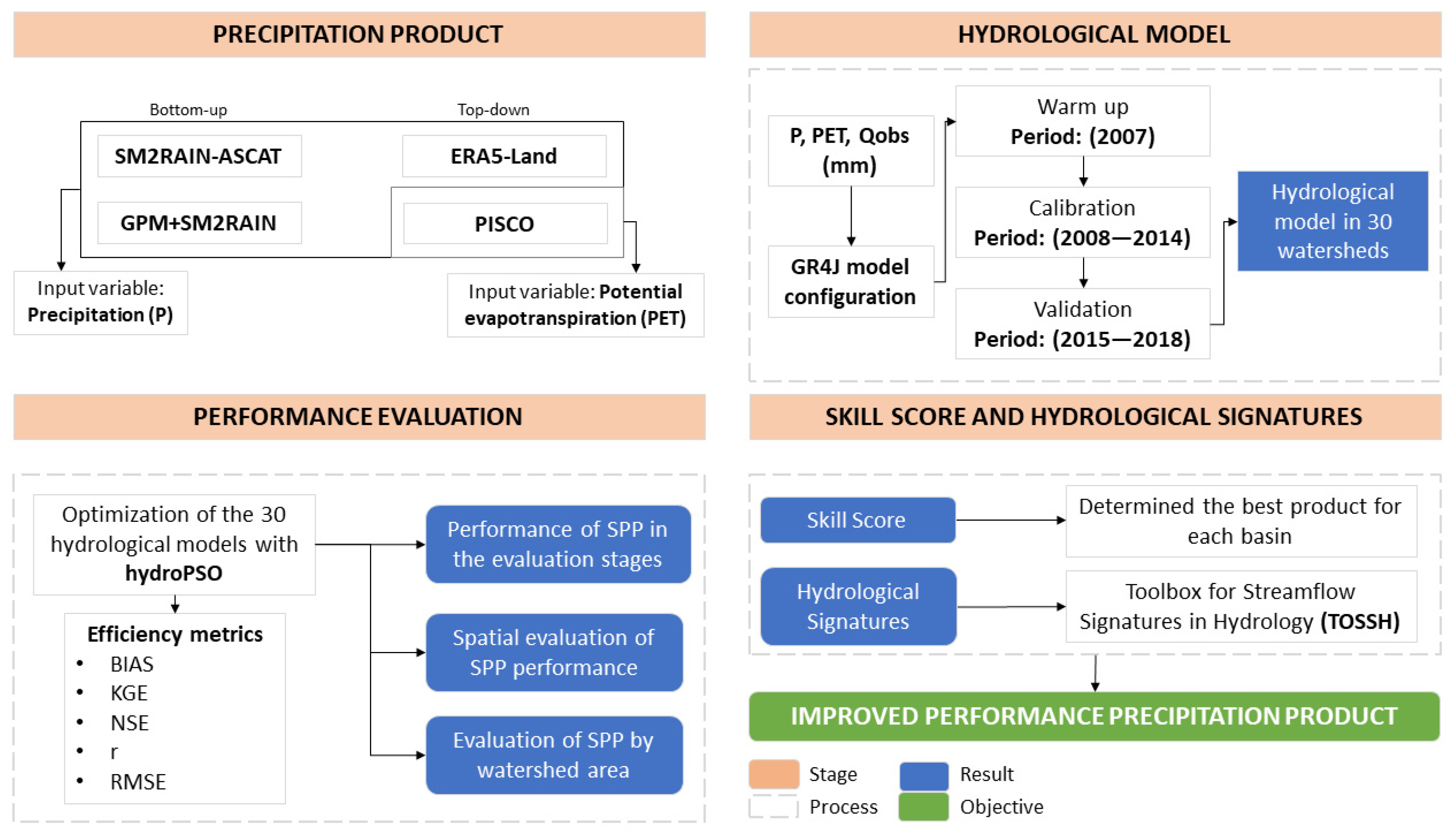

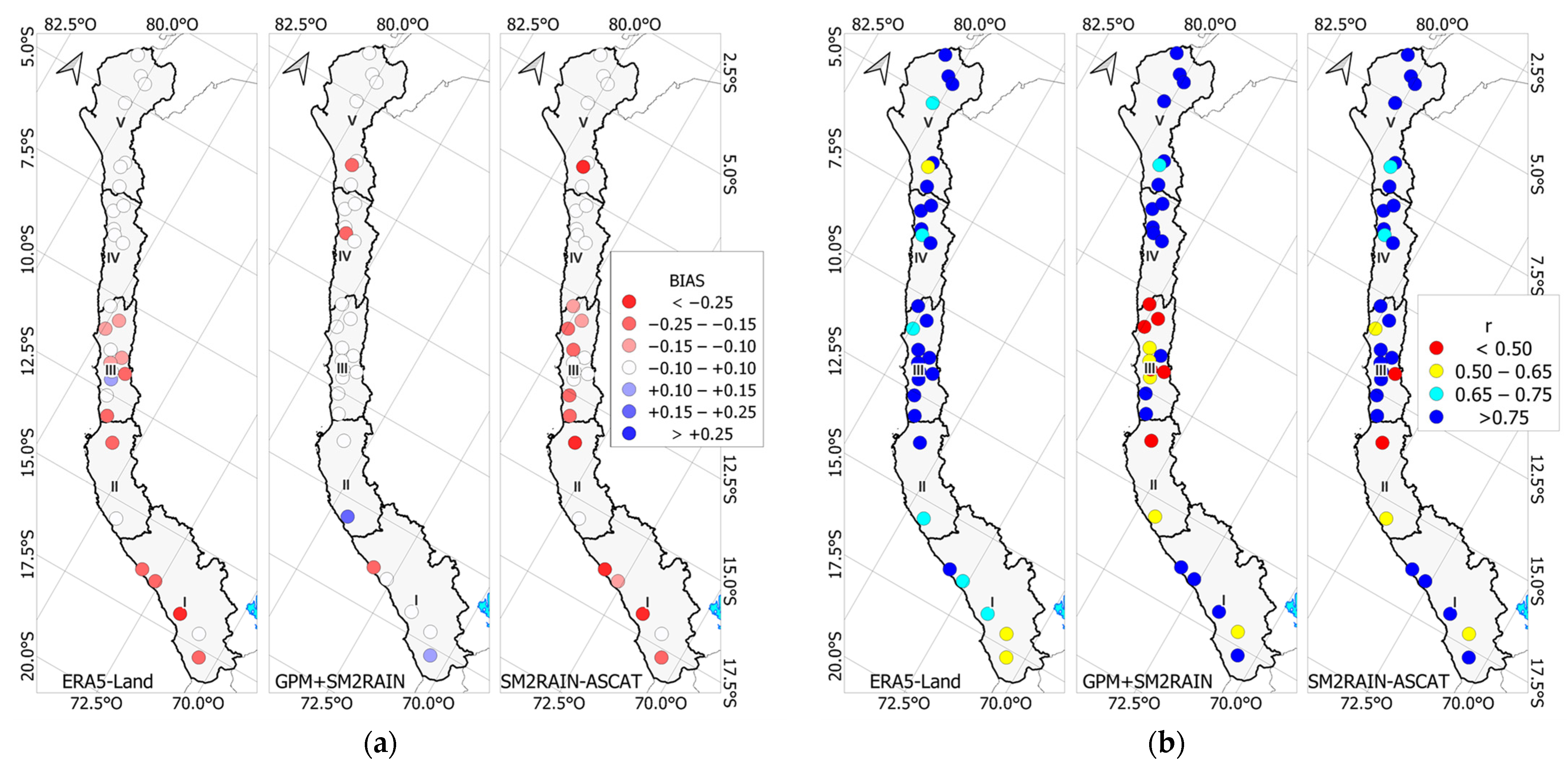
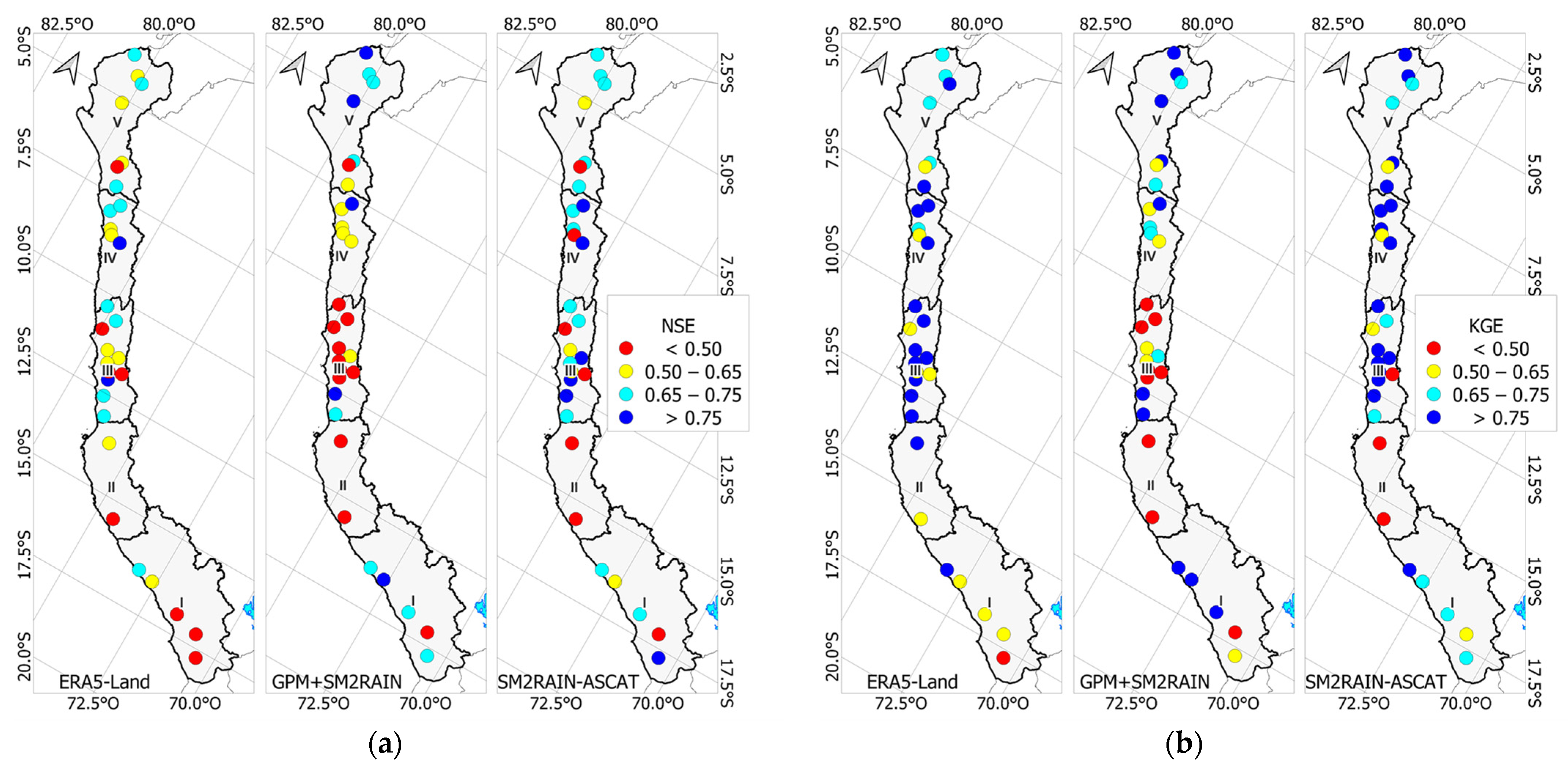

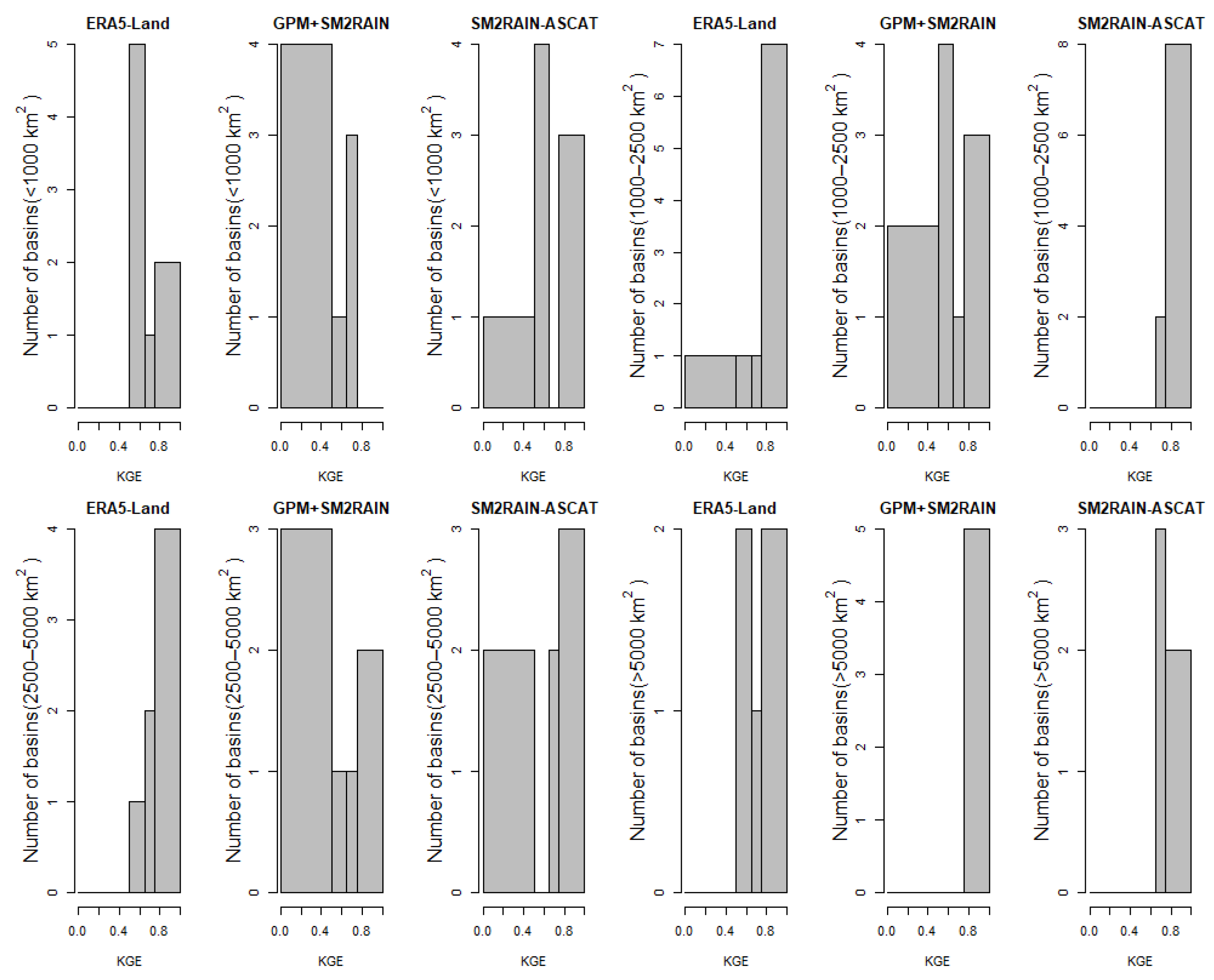
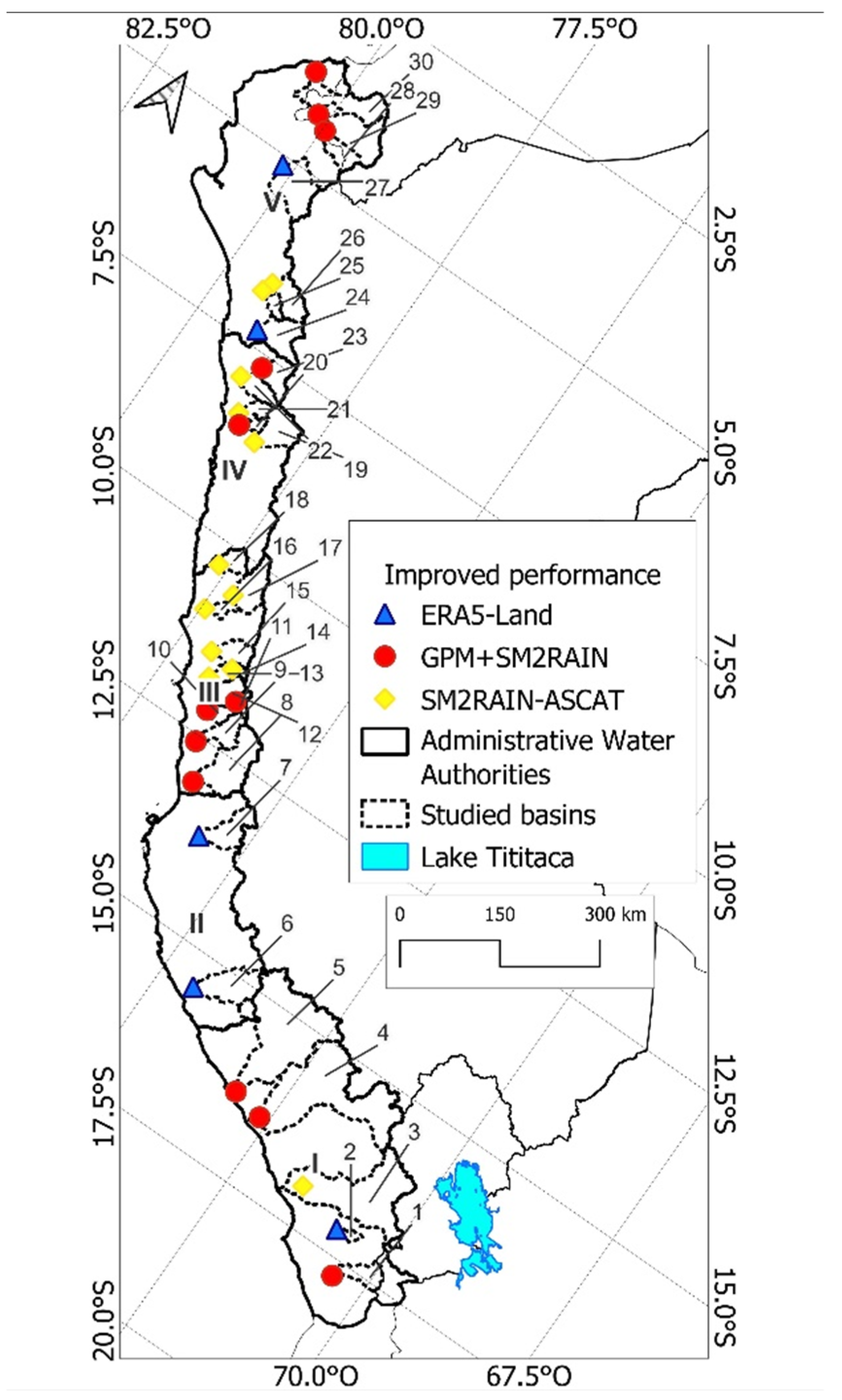
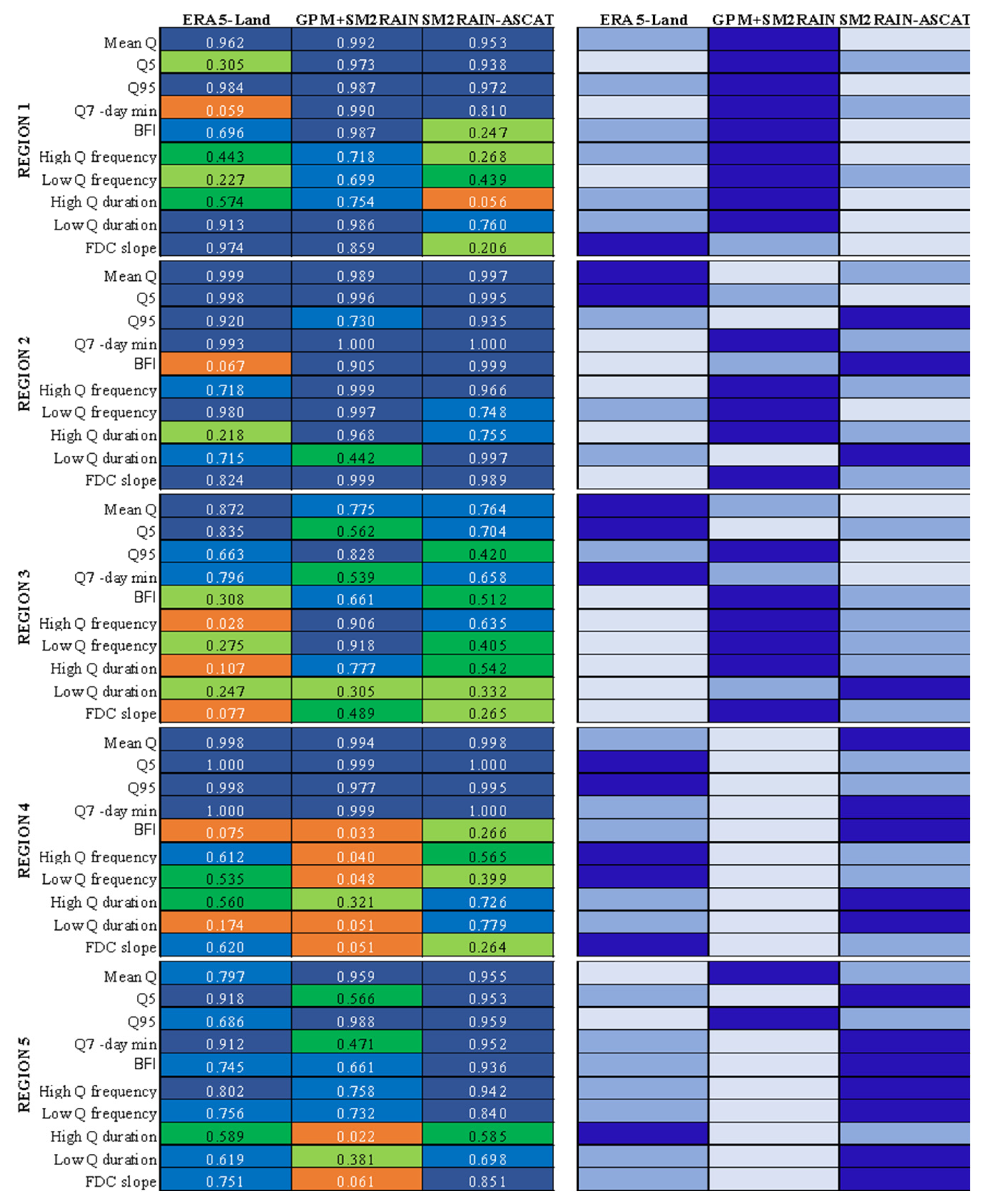
| Region (AAA) | ID | Hydrometric Station | Basin | Flow (mm/day) | Area (km2) |
|---|---|---|---|---|---|
| Region I: Caplina-Ocoña | 1 | La Tranca | Sama | 2.16 | 1937 |
| 2 | Tumilaca | Ilo-Moquegua | 0.91 | 462 | |
| 3 | La Pascana | Tambo | 13.7 | 13,020 | |
| 4 | Huatipa | Camaná | 71.8 | 16,937 | |
| 5 | Ocoña | Ocoña | 95.08 | 16,029 | |
| Region II: Chaparra-Chincha | 6 | Yauca | Yauca | 5.47 | 4113 |
| 7 | Letrayoc | Pisco | 41.79 | 3079 | |
| Region III: Cañete-Fortaleza | 8 | Socsi | Cañete | 46.16 | 5786 |
| 9 | La Capilla | Mala | 13.48 | 2145 | |
| 10 | Antapucro | Lurín | 6.74 | 996 | |
| 11 | Tamboraque | Rímac | 15.31 | 576 | |
| 12 | Chosica | Rímac | 1.24 | 2305 | |
| 13 | Puente Magdalena | Chillón | 0.47 | 1246 | |
| 14 | Obrajillo | Chillón | 5.74 | 365 | |
| 15 | Santo Domingo | Chancay-Huaral | 17.07 | 1835 | |
| 16 | Las Minas | Supe | 8.49 | 766 | |
| 17 | Cahua | Pativilca | 38.01 | 2949 | |
| 18 | Malvados | Chicama | 10.65 | 1378 | |
| Region IV: Huarmey-Chicama | 19 | Condorcerro | Santa | 143.43 | 3176 |
| 20 | Huamansaña | Huamansaña | 0.91 | 718 | |
| 21 | Huacapongo | Virú | 5.68 | 908 | |
| 22 | Quirihuac | Moche | 8.44 | 1762 | |
| 23 | El Tambo | Tambo | 0.97 | 2183 | |
| Region V: Jequetepeque-Zarumilla | 24 | Yonán | Jequetepeque | 32.69 | 3298 |
| 25 | Batan | Zaña | 8.51 | 797 | |
| 26 | Raca Rumi | Chancay-Lambayeque | 38.49 | 2362 | |
| 27 | Puente Ñacara | Piura | 1.09 | 4495 | |
| 28 | Puente Internacional Macara | Chira | 1.99 | 1851 | |
| 29 | Ciruelo | Chira | 115.37 | 6979 | |
| 30 | El Tigre | Tumbes | 113.37 | 4663 |
| Region (AAA) | ID | Minimun | Mean | Median | Maximun | ||||||||
|---|---|---|---|---|---|---|---|---|---|---|---|---|---|
| (A) | (G) | (E) | (A) | (G) | (E) | (A) | (G) | (E) | (A) | (G) | (E) | ||
| Region I: Caplina-Ocoña | 1 | 0.0 | 0.0 | 0.0 | 2.1 | 0.6 | 1.8 | 0.5 | 0.0 | 0.1 | 20.5 | 22.0 | 34.6 |
| 2 | 0.0 | 0.0 | 0.0 | 2.1 | 0.4 | 2.2 | 0.5 | 0.0 | 0.4 | 20.5 | 13.7 | 23.3 | |
| 3 | 0.0 | 0.0 | 0.0 | 1.7 | 1.1 | 2.6 | 0.6 | 0.1 | 1.0 | 10.3 | 11.6 | 23.6 | |
| 4 | 0.0 | 0.0 | 0.0 | 2.0 | 1.2 | 2.4 | 1.1 | 0.2 | 0.8 | 9.9 | 11.3 | 33.3 | |
| 5 | 0.0 | 0.0 | 0.0 | 2.7 | 1.6 | 3.0 | 1.3 | 0.4 | 1.5 | 17.0 | 11.6 | 23.8 | |
| Region II: Chaparra-Chincha | 6 | 0.0 | 0.0 | 0.0 | 4.7 | 1.1 | 3.9 | 4.0 | 0.2 | 2.4 | 18.1 | 11.7 | 28.6 |
| 7 | 0.0 | 0.0 | 0.0 | 2.9 | 0.9 | 4.2 | 1.0 | 0.0 | 3.1 | 23.6 | 19.1 | 29.4 | |
| Region III: Cañete-Fortaleza | 8 | 0.0 | 0.0 | 0.0 | 3.7 | 1.8 | 4.5 | 2.6 | 0.6 | 3.3 | 16.9 | 17.5 | 29.7 |
| 9 | 0.0 | 0.0 | 0.0 | 3.5 | 1.8 | 4.6 | 2.7 | 0.8 | 3.9 | 13.5 | 28.1 | 43.4 | |
| 10 | 0.0 | 0.0 | 0.0 | 3.3 | 1.3 | 4.8 | 2.5 | 0.3 | 4.0 | 12.9 | 13.0 | 46.6 | |
| 11 | 0.0 | 0.0 | 0.0 | 4.2 | 0.9 | 5.5 | 3.3 | 0.1 | 4.8 | 17.2 | 13.0 | 29.6 | |
| 12 | 0.0 | 0.0 | 0.0 | 3.9 | 1.9 | 5.1 | 3.8 | 0.5 | 4.2 | 18.2 | 26.7 | 25.6 | |
| 13 | 0.0 | 0.0 | 0.0 | 4.4 | 1.4 | 5.3 | 4.0 | 0.5 | 3.7 | 21.2 | 13.4 | 65.9 | |
| 14 | 0.0 | 0.0 | 0.0 | 3.9 | 2.2 | 4.0 | 4.0 | 0.9 | 3.0 | 17.1 | 22.7 | 33.9 | |
| 15 | 0.0 | 0.0 | 0.0 | 5.1 | 1.7 | 5.6 | 4.4 | 0.7 | 4.4 | 24.0 | 24.0 | 26.9 | |
| 16 | 0.0 | 0.0 | 0.0 | 2.2 | 0.5 | 2.5 | 1.2 | 0.0 | 1.2 | 14.9 | 9.0 | 22.1 | |
| 17 | 0.0 | 0.0 | 0.0 | 4.7 | 2.6 | 5.1 | 4.4 | 1.9 | 4.0 | 16.7 | 18.1 | 28.4 | |
| 18 | 0.0 | 0.0 | 0.0 | 4.3 | 1.1 | 4.9 | 2.9 | 0.4 | 3.7 | 20.5 | 9.6 | 26.8 | |
| Region IV: Huarmey-Chicama | 19 | 0.0 | 0.0 | 0.0 | 5.5 | 2.1 | 5.9 | 4.9 | 1.0 | 4.7 | 26.0 | 14.0 | 36.1 |
| 20 | 0.0 | 0.0 | 0.0 | 3.9 | 1.0 | 4.0 | 2.8 | 0.2 | 2.7 | 27.5 | 15.0 | 37.7 | |
| 21 | 0.0 | 0.0 | 0.0 | 5.0 | 1.4 | 4.8 | 4.0 | 0.5 | 3.6 | 33.3 | 20.5 | 34.4 | |
| 22 | 0.0 | 0.0 | 0.0 | 4.1 | 1.4 | 4.2 | 3.0 | 0.4 | 3.1 | 24.4 | 20.6 | 34.5 | |
| 23 | 0.0 | 0.0 | 0.0 | 5.3 | 2.1 | 6.1 | 4.0 | 0.8 | 4.3 | 30.9 | 22.8 | 40.9 | |
| Region V: Jequetepeque-Zarumilla | 24 | 0.0 | 0.0 | 0.0 | 6.7 | 2.2 | 5.8 | 5.4 | 0.8 | 3.9 | 31.2 | 28.1 | 56.3 |
| 25 | 0.0 | 0.0 | 0.0 | 5.3 | 1.6 | 3.2 | 3.7 | 0.0 | 0.9 | 29.2 | 21.5 | 48.5 | |
| 26 | 0.0 | 0.0 | 0.0 | 5.0 | 2.5 | 4.5 | 4.1 | 0.9 | 3.4 | 25.1 | 28.8 | 35.3 | |
| 27 | 0.0 | 0.0 | 0.0 | 4.2 | 1.8 | 5.2 | 1.7 | 0.4 | 3.4 | 66.8 | 41.4 | 110.9 | |
| 28 | 0.0 | 0.0 | 0.0 | 5.5 | 4.0 | 5.5 | 2.8 | 1.6 | 2.3 | 45.8 | 47.2 | 138.3 | |
| 29 | 0.0 | 0.0 | 0.0 | 5.2 | 3.7 | 6.0 | 3.3 | 1.4 | 3.3 | 33.5 | 42.9 | 90.2 | |
| 30 | 0.0 | 0.0 | 0.0 | 6.7 | 3.2 | 7.3 | 4.8 | 0.8 | 4.7 | 38.6 | 41.9 | 96.6 | |
| Parameter | Unit | Description |
|---|---|---|
| R | m | Initial water level in the first reservoir |
| S | m | High of the second reservoir |
| Parameter | Unit | Description | Initial Value |
|---|---|---|---|
| X1 | m | First reservoir capacity | 5.9 |
| X2 | m | Water interchange coefficient | 0.0 |
| X3 | m | Second reservoir capacity | 4.5 |
| X4 | dt | Base time of the unit hydrograph | 0.2 |
| Statistics | Equation | Ideal Value |
|---|---|---|
| Nash Sutcliffe Efficiency | 1 | |
| Kling Gupta Efficiency | 1 | |
| Root Mean Square Error | 0 | |
| Relative Bias | 0 | |
| Pearson Correlation coefficient | 1 |
| Performance Rating | NSE | BIAS |
|---|---|---|
| Very Good | 0.75–1.00 | ≤±10 |
| Good | 0.65–0.75 | ±10–±15 |
| Satisfactory | 0.50–0.65 | ±15–±25 |
| Unsatisfactory | <0.50 | ≥±25 |
| Attribute | Long Name | Unit |
|---|---|---|
| Mean Q | Mean daily streamflow | mm.day−1 |
| Q5 | Streamflow 5th quantile | mm.day−1 |
| Q95 | Streamflow 95th quantile | mm.day−1 |
| Q7-day min | 7-day minimum streamflow | - |
| High Q frequency | Max streamflow frequency | y−1 |
| High Q duration | Max streamflow duration Min streamflow frequency | days |
| Low Q frequency | Min streamflow duration | y−1 |
| Low Q duration | Mean daily streamflow | days |
| BFI | Baseflow index | - |
| FDC slope | The slope of the flow duration curve | - |
Disclaimer/Publisher’s Note: The statements, opinions and data contained in all publications are solely those of the individual author(s) and contributor(s) and not of MDPI and/or the editor(s). MDPI and/or the editor(s) disclaim responsibility for any injury to people or property resulting from any ideas, methods, instructions or products referred to in the content. |
© 2023 by the authors. Licensee MDPI, Basel, Switzerland. This article is an open access article distributed under the terms and conditions of the Creative Commons Attribution (CC BY) license (https://creativecommons.org/licenses/by/4.0/).
Share and Cite
Qquenta, J.; Rau, P.; Bourrel, L.; Frappart, F.; Lavado-Casimiro, W. Assessment of Bottom-Up Satellite Precipitation Products on River Streamflow Estimations in the Peruvian Pacific Drainage. Remote Sens. 2024, 16, 11. https://doi.org/10.3390/rs16010011
Qquenta J, Rau P, Bourrel L, Frappart F, Lavado-Casimiro W. Assessment of Bottom-Up Satellite Precipitation Products on River Streamflow Estimations in the Peruvian Pacific Drainage. Remote Sensing. 2024; 16(1):11. https://doi.org/10.3390/rs16010011
Chicago/Turabian StyleQquenta, Jonathan, Pedro Rau, Luc Bourrel, Frédéric Frappart, and Waldo Lavado-Casimiro. 2024. "Assessment of Bottom-Up Satellite Precipitation Products on River Streamflow Estimations in the Peruvian Pacific Drainage" Remote Sensing 16, no. 1: 11. https://doi.org/10.3390/rs16010011
APA StyleQquenta, J., Rau, P., Bourrel, L., Frappart, F., & Lavado-Casimiro, W. (2024). Assessment of Bottom-Up Satellite Precipitation Products on River Streamflow Estimations in the Peruvian Pacific Drainage. Remote Sensing, 16(1), 11. https://doi.org/10.3390/rs16010011







